#digital technology in Germany
Explore tagged Tumblr posts
Text
Gleecus TechLabs Inc., one of the fastest growing US-based innovative IT Consulting firms, is thrilled to announce its strategic expansion into the European market. This strategic move is in line with our vision to enhance our global footprint and provide unparalleled Digital Transformation solutions to a wider client base.
#digital transformation#technology#tech#it consulting#it services#technology trends#tech news#europe#europe expansion#united kingdom#germany#business expansion#einpresswire
0 notes
Text
"France is to trial a ban on mobile phones at school for pupils up to the age of 15, seeking to give children a “digital pause” that, if judged successful, could be rolled out nationwide from January [2025].
Just under 200 secondary schools will take place in the experiment that will require youngsters to hand over phones on arrival at reception. It takes the prohibition on the devices further than a 2018 law that banned pupils at primary and secondary schools from using their phones on the premises but allowed them to keep possession of them.
Announcing the trial on Tuesday, the acting education minister, Nicole Belloubet, said the aim was to give youngsters a “digital pause”. If the trial proves successful, the ban would be introduced in all schools from January, Belloubet said.
A commission set up by the president, Emmanuel Macron, expressed concern that the overexposure of children to screens was having a detrimental effect on their health and development.
A 140-page report published in March concluded there was “a very clear consensus on the direct and indirect negative effects of digital devices on sleep, on being sedentary, a lack of physical activity and the risk of being overweight and even obese … as well as on sight”.
It said the “hyper” use of phones and other digital technology was not only bad for children but also for “society and civilisation”.
The report recommended children’s use of mobile phones be controlled in stages: no mobile phones before the age of at least 11, mobiles without internet access between 11 and 13, phones with internet but no access to social media before 15.
It also suggested children under three years old should not be exposed at all to digital devices, which it said were “not necessary for the healthy development of the child”.
“We must put the digital tool in its place. Up to at least six years old a child has no need for a digital device to develop,” Servane Mouton, a neurologist and neurophysiologist who was on the commission, said. “We have to teach parents once again how to play with their children.”
Banning phones in schools has long been debated across Europe. In countries where bans exist this is most often confined to their use and do not require children to hand them over.
In Germany there are no formal restrictions but most schools have prohibited the use of mobile phones and digital devices in classrooms except for education purposes. A quasi ban has been in place in Dutch secondary school classrooms since the beginning of this year, but as a recommendation and not a legal obligation. From this school year the directive will also apply to primary schools.
Italy was early to phone bans, introducing one in 2007 before easing it in 2017 and reimposing it in 2022. It applies to all age groups.
In February this year, the Westminster government issued non-statutory guidance that said schools in England should prohibit the use of mobile phones throughout the school day, but that it was for individual headteachers and leaders to decide on their phone use policy.
Portugal is experimenting with a compromise by introducing a number of phone-free days at schools each month, while in Spain schools in some autonomous regions have imposed a ban but there is no nationwide prohibition."
-via The Guardian, August 27, 2024
#public school#school#france#england#germany#uk#italy#cell phone#phone#technology#tech news#good news#hope#cell phone ban
105 notes
·
View notes
Text
Now here’s a divine development.
Just ahead of the holidays, archaeologists have “digitally unrolled” a 1,800-year-old silver amulet to decipher an inscription that’s being hailed as the oldest known evidence of Christianity in Europe.
Authentic evidence of pure Christianity north of the Alps has never existed before now. And the findings have the potential to change holy history forever.
“It will force us to turn back the history of Christianity in Frankfurt and far beyond by around 50 to 100 years,” said Mike Josef, mayor of Frankfurt, Germany, where the artifact was exhumed.
“The first Christian find north of the Alps comes from our city,” added Josef. “We can be proud of that, especially now, so close to Christmas.”
The amulet housed a “wafer-thin” foil, measuring 1.4 inches, and featuring text referred to as the “Frankfurt silver inscription.”
It was found beneath the chin of a man’s skeleton at a burial site on the outskirts of Frankfurt in 2018. However, the ancient wording, dating back to between 230 and 270 — when the predominant religions in Europe were Judaism and paganism — has been virtually illegible until now.
Specialists from the Leibniz Center for Archaeology (LEIZA) used computer tomography (CT) scans to decode the 18-line engraving, which declares Jesus Christ the “Son of God.”
“In the name of Saint Titus. Holy, holy, holy! In the name of Jesus Christ, Son of God! The Lord of the world resists with [strengths] all attacks [or setbacks]. The God grants entry to well-being. May this means of salvation protect the man who surrenders himself to the will of the Lord Jesus Christ, Son of God, since before Jesus Christ every knee bows: those in heaven, those on earth and those under the earth, and every tongue confesses (Jesus Christ),” reads the translation, per DailyMail.
The deific discovery closely trails the recent decrypting of the Meggido Mosaic, a 1,800-year-old relic that says, “Jesus is God.” It also follows the July 2024 unearthing of a nearly 2,000-year-old manuscript that details the earliest known account of Christ’s childhood.
To crack the code on the Frankfurt silver inscription, which is written in Latin, LEIZA experts used sophisticated technologies on the extremely delicate scroll.
“The challenge in the analysis was that the silver sheet was rolled, but after around 1,800 years, it was of course also creased and pressed,” Ivan Calandra, an archaeologist at LEIZA, said in a statement. “Using CT, we were able to scan it at a very high resolution and create a 3D model.”
The pros reportedly placed individual segments of the scan together, piece by piece, until most of the words were visible.
However, there are said to be a few gaps in the text — which is being dubbed “purely Christian” as it spotlights Jesus Christ and Saint Titus, a missionary and church leader, but avoids pagan themes as well as elements of Judaism.
Professor Markus Scholz, an archaeologist from Goethe University in Frankfurt, helmed the deciphering efforts.
“I called in experts from the history of theology, among others, and we approached the text together, piece by piece, and finally deciphered it,” said Scholz, who was surprised that the etchings were in Latin.
“Such inscriptions in amulets were usually written in Greek or Hebrew,” he noted.
And while little is known about the man who was buried with the amulet, scientists reportedly believe that he was a devout Christian — although believers of the faith were still subject to persecution at the time of his death.
According to insiders, the late Jesus-lover likely wore the amulet on a cord around his neck for protection before transitioning into the afterlife. His grave also boasted an incense bowl and a jug made of fired clay.
Researchers consider him the “first Christian north of the Alps,” and speculate that there could be more historical, untapped Christian burial sites around Europe.
“This extraordinary find affects many areas of research and will keep science busy for a long time to come,” said Ina Hartwig, Frankfurt’s head of culture and science.
“This affects archaeology as well as religious studies, philology and anthropology,” she continued. “Such a significant find here in Frankfurt is really something extraordinary.”
#nunyas news#well that's all kinds of cool#doen't upend a thing either#just confirms what we already know
36 notes
·
View notes
Text
The Nara Smiths of this World
I'd like to begin with saying in no way, shape, or form, will I be bashing the beautiful Black woman, wife and mother, Nara Smith. I actually aspire to be like her.

I also prefer content and media (both digital and physical) that cater to the life I have been creating for myself:
Led by God
With a God-fearing man (soon to be my fiancé - then husband, God-willing),
As a wife and mother,
While having the time and ease to do things that bring me peace and happiness like basking in the sun, working out, creating dinner experiences, rolling in academia - simultaneously having a career with a lower tempo, hints my transition from one career field to another (another post for another day).
I love watching her content, especially all of the dishes she makes from scratch.
But what upsets me, are the Black women that make a mockery of her lifestyle and make the excuse like "who wants to be a traditional wife" or "ain't nobody got time for all of that" and people saying that her lifestyle is unrealistic.
Lets be real.
A lot of women who bash Nara Smith are jealous.
Nara Smith is a young woman who is also a model, married, with two children and a third on the way.

Besides being a model, what about my previous statement is unrealistic or unattainable?
"Well who makes everything from scratch like that?!"
Everyone outside of the United States of America, darling.
I implore all the women who read my blog to please travel outside of the United States. Everyone makes everything from scratch and not only is it healthier, it taste amazing.



My first experience in Europe was the Summer of 2017, as an intern at the University of Science and Technology in Bydgoszcz, Poland.
While interning, I also traveled to Germany and Amsterdam.
During my tenure in Europe, I walked everywhere, used public transportation (it was clean, on time and efficient if I may add), went to people's homes where they made their authentic dishes and simple ones from scratch - while simultaneously losing 15lbs, and not on purpose.
Making your desired entrees from scratch versus using products that are processed and already made with preservatives are better for your health. Not only do you taste the difference but you will feel the difference.

Back to the point of women being jealous of Nara Smith's more traditional lifestyle and leisure:
The unfortunate truth of this - speaking as a Black woman with real Black Women experiences - so many Black women are truly perturbed by Nara's choice to take the time to cater to her children, household and husband as she does.
I think most of this disturbance comes from the fact that as Black women, we're told from early youth to work so hard and earn so many accolades where we do not need a man/husband and to not submit to the idea of motherhood and marriage until you receive every possible degree, award and accomplishment - which turns into us working just as hard as men to achieve a certain status, settling down in our mid 30s, yikes!
I have recently transitioned from one career field to another due to my desire to not only become a wife, but a mother.
But not an overworked wife who does not have time to cater to herself, household and husband, but a mother who has the time to be as hands-on as possible, make dinner, be a part of the Parent Teacher Association (PTA), etc.
This was my reality as a child. My parents were married; My father had a career that pulled him away sometimes but he was providing a comfortable life for my mother, sister and I. My mother chose to have an at-home daycare so she can make my sister and I breakfast in the morning, be home to receive us after school, help us with our lessons, and put us to sleep. She was intentional with her career choice so she could cater to herself, take care of her home and her family.
And there is nothing wrong with a woman choosing to still work to have some independence, but choosing a career that is not as demanding that she sacrifices her family for it.
I brought all of this up due to conversations I had with women in my previous line of work who tried to convince me that I could "have it all" as they like to say: meaning that I could have the demanding career and title, be married, and have children.
Anyone who knows me personally, knows that I am extremely observant. During the last four years in my career field, I paid attention and listened quite carefully to the women who had children in both orthodox and unorthodox manners. The women who were married, with a child or children said all of the following:
"There was a time I spent a year away from my child, leaving them at three months of age."
"I was on my feet working just to go home and still be working."
"I got divorced because he couldn't understand that I wanted a certain level of success and being at home would not push me towards that goal."
"I don't even have time for myself."
"I have missed so many important moments."
Mind you, there's more. And I'm not saying that you cannot be married, with children and have a demanding career. I just believe it is irresponsible for older career woman to perpetuate the narrative that you can have 100% of everything all at the same time - when it's not true. Something or someone is going to be neglected.
So when I chose to transition out of my previous occupation, all of these women kept trying to persuade me to stay, but then I looked at their lives, it was not what I wanted:
Woman 1: Divorced with a boyfriend, three children (two different fathers) - spent months at a time away from her children, struggles with being feminine; Top of the food chain at work.
Woman 2: Married closer to 40, one child, lives a flight away from her husband to keep her demanding career, spends weeks away from her son.
Woman 3: Divorced, two children, sleeping around (with people we know) and the joke of our department, falls in love fast, one son has joined a gang, ex-husband is in-and-out of jail; Has worked for our organization for 15 years.
Woman 4: Left her newborn after two months to take a position in another country for a year, marriage suffered tremendously, also another "big dog" for the organization.

Now, as a woman who wants the lifestyle I already described in the paragraphs at the beginning of my piece, are these stories that I would want to emulate?
ABSOLUTELY NOT!
I won't go as far as saying that this is every woman's reality who has a demanding career, but even the women who stay married and have children have also told me that their marriage suffered tremendously and there is a closeness they lack with their children.
And again, that statement is not for the totality of working woman, but it's a shared experience of most.
When I told multiple women that I am ready to be a wife and a mother I was told I would regret it.
I don't and I won't.
I've had a job since I was 16; I have dated, traveled, lived in the city and suburbs on my own, and my truest desire is to live a life of leisure and peace, with my future husband and children.
So, for the girlies who are ready to settle down, leave the busy careers behind, do it!

Side bar - I just turned 26, I want to have my first child before 30 (and after I am married of course).
And do not, I repeat, DO NOT allow people's opinions, especially your Black female peers (it is what it is), to dissuade you from the lifestyle you truly desire, because they are the same women who complain about how miserable they are because of their choices, and misery loves company.
Choose your family, choose love, choose yourself.

With Love,
Sarah Chanel
#black women#black women in luxury#luxuriousbw#luxury#black femininity#black women in leisure#black women fashion#blackwomen#black beauty#nara smith#motherhood#marriage#relationships#happiness
95 notes
·
View notes
Text
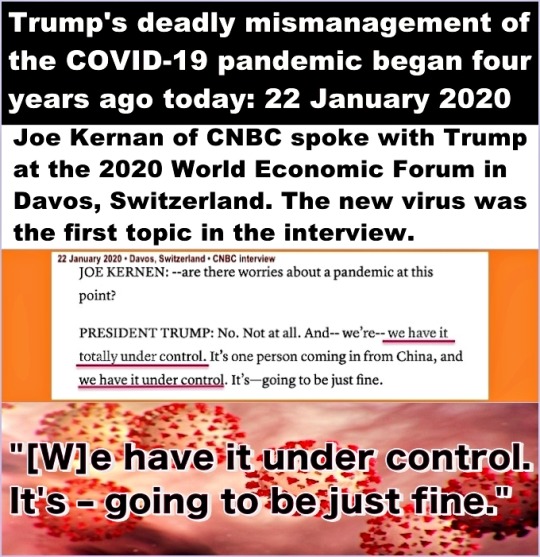
Just so nobody can say this is out of context, here's a vid of the entire interview.
The Obama administration successfully contained the Ebola outbreak in the United States. The death toll for Ebola in the US was under a dozen. So before leaving office, the Obama National Security Council created a 69-page handbook on how to deal with a pandemic. Trump and his flunkies ignored it with disastrous results.
Trump team failed to follow NSC’s pandemic playbook
The US death toll from COVID-19 is in seven digits. Other industrialized countries with advanced technological infrastructure such as Canada, Taiwan, Germany, and New Zealand had lower fatality rates per capita.
Trump largely ignored the virus until well into March when it had a chance to spread across the US.
The missing six weeks: how Trump failed the biggest test of his life The president was aware of the danger from the coronavirus – but a lack of leadership has created an emergency of epic proportions
The Trump administration, at best, was in denial; at worst, it sabotaged the pandemic response.
youtube
Trump White House made 'deliberate efforts' to undermine Covid response, report says
Trump zombies who claim the economy was marvelous under Trump conveniently forget about everything that happened after February of 2020. Trump's early bungling of the pandemic plunged the economy into recession. The COVID supply chain problems and the economic stimulus required to prevent a depression led to the spurt in inflation which is finally receding.
People who are nostalgic about taking hydroxychloroquine and ivermectin, drinking bleach, and sticking UV lights up their butts must be excited about the opportunity to vote for Trump again.
#donald trump#botched pandemic response#covid-19#coronavirus#public health#anniversary of trump's awful covid-19 response#gross incompetence of the trump administration#the trump recession#trump tanked the economy#trump is a loser#vote blue no matter who#election 2020#election 2024
123 notes
·
View notes
Text

1,800-Year-Old Silver Amulet Could Rewrite Christianity in the Early Roman Empire
A small, silver amulet found alongside a skeleton in a cemetery in Germany may be the oldest evidence of Christianity north of the Alps, new research suggests.
A 1,800-year-old silver amulet discovered beneath the chin of a skeleton in a cemetery in Germany is the oldest evidence of Christianity north of the Alps, according to a new study.
Researchers made the discovery by digitally unrolling a tiny scroll inside the amulet using CT scanning technology; this revealed an unusual Latin inscription. The finding may upend historians' understanding of how Christianity was practiced in the early Roman Empire.



Measuring just 1.4 inches (3.5 centimeters) long, the amulet contains a wafer-thin sheet of silver foil that's rolled up tightly. Archaeologists discovered it in the grave of a man who died between A.D. 230 and 270. The man likely wore the amulet on a cord around his neck, as it was found just below his jaw.
The discovery was made by digitally unrolling a tiny silver scroll, which would have likely been worn on a cord around the neck. The inscription inside speaks of the owner's devout faith and changes what we thought we knew about Christianity in the third century A.D. in that region.
"This takes our understanding of Western Christianization and Christian monotheism to a whole new level!" an independent biblical archaeologist.
By Pandora Dewan.



#1800-Year-Old Silver Amulet Could Rewrite Christianity in the Early Roman Empire#silver#silver amulet#ancient jewelry#ancient grave#ancient tomb#ancient artifacts#archeology#archeolgst#history#history news#ancient history#ancient culture#ancient civilizations#roman history#roman empire
39 notes
·
View notes
Text
🌙✨2025, The Year Everything Changes, and Why Astrologers are sweating✨🌙
February 11th 2025
2025: The Year Everything Changes – And Why Astrologers Are Sweating
Right, listen up—2025 is not a normal year.
If you’ve been feeling like the world is on the edge of something massive, you’re not wrong. This isn’t just another ‘big astrology year’ where Mercury retrogrades a bit, and your ex reappears. This is one of those rare years where history shifts permanently—a complete collapse of the old world and the birth of something new.
And astrologers? They’re sweating.
Because when we look back, the last time we saw these planetary shifts, entire empires fell, revolutions kicked off, and the world as people knew it ended.
So let’s talk about what’s coming—and why 2025 will be one of the most significant years of our lifetime.
☠️ 1. Pluto in Aquarius (2024–2043): The Last Time? Revolutions, Science, and the Fall of Monarchies
Pluto—the planet of death, rebirth, power, and transformation—has just moved into Aquarius, where it’ll stay for nearly 20 years. The last time Pluto was here? The late 1700s.
And what happened? Absolute chaos and revolution.
🔥 The American Revolution (1775–1783) – The United States was literally born out of rebellion during Pluto in Aquarius. A bunch of colonies decided they didn’t fancy being ruled by a king, and boom—democracy.
🔪 The French Revolution (1789–1799) – The people of France had enough of their monarchy and executed their king and queen. It wasn’t just a political shift—it was a complete destruction of the old system.
⚙️ The First Industrial Revolution – Factories, steam engines, and machinery completely transformed the way people worked and lived. It was the beginning of mass urbanisation and capitalism as we know it.
🧠 The Age of Enlightenment – Science, philosophy, and new political ideas challenged religion and traditional authority. Think of it as the era where people started saying, “Wait… why are we listening to kings and priests when we can use reason instead?”
What This Means for 2025+
• The collapse of old power structures – Governments, corporations, and billionaires will struggle to keep control.
• Technology will explode – AI, automation, and robotics will change society forever—and not everyone will be happy about it.
• Decentralisation of power – Cryptocurrency, AI governance, and digital societies could replace traditional leadership.
• Mass protests and revolutions – People are done with inequality. Expect uprisings, movements, and shifts towards direct democracy.
🌊 2. Neptune in Aries (2025–2039): War, Crusades, and Ideological Clashes
Neptune—the planet of dreams, illusions, and spirituality—moves into Aries, the sign of war and action, for the first time since 1861. The last time Neptune was here? The world was on fire.
⚔️ The American Civil War (1861–1865) – A brutal, ideological war tore a nation apart over slavery, identity, and control.
👻 The Spiritualist Movement exploded – People became obsessed with ghosts, séances, and the afterlife, trying to communicate with the dead.
🇩🇪 The unification of Germany and Italy – Entire nations were restructured through wars and nationalism.
📖 Karl Marx wrote Das Kapital – The book that inspired communism and socialism was published, challenging capitalism and shaping global politics for centuries.
What This Means for 2025+
• New ideological wars – AI vs. humans? Capitalism vs. alternative economies? The battleground is shifting.
• A rise in spiritual extremism – New religious movements and cults will take advantage of uncertainty.
• Economic collapse and transformation – Just like Marx’s work changed the global economy, we’re heading for a massive financial shift—and not everyone will like it.
• A generation searching for meaning – Expect huge spiritual awakenings—but also dangerous movements trying to manipulate people.
💡 3. Uranus in Gemini (2025–2033): The Last Time? World War II, Propaganda, and Technological Leaps
Uranus—the planet of disruption, rebellion, and technology—moves into Gemini, the sign of communication, media, and ideas. And last time this happened (1942–1949), the world saw:
💣 World War II’s final years – The atomic bomb changed warfare forever.
📡 The rise of propaganda – Governments used radio, newspapers, and film to shape public opinion like never before.
🖥 The birth of modern computing – The digital world was literally born during this transit.
What This Means for 2025+
• AI-generated propaganda – Expect deepfakes, misinformation, and manipulated media so advanced that reality itself will be questioned.
• A new digital consciousness – Just like the 1940s brought TV and computing, we’re heading for another radical shift in how we communicate.
⚖️ 4. The Saturn-Neptune Conjunction (Feb 2026): The Collapse of Illusions
Every 36 years, Saturn and Neptune meet up, exposing what’s real and what’s a lie. The last times?
🔴 1989 – The Berlin Wall falls, the USSR collapses, the Cold War ends.
⚠️ 1953 – The discovery of DNA, but also Cold War paranoia and McCarthyism.
☠️ 1917 – The Russian Revolution, World War I intensifies.
What This Means for 2025-2026
• Major governments or institutions could collapse.
• Radical shifts in global power.
• Mass awakenings—some enlightening, some deeply disillusioning.
⏳ 2025: A Point of No Return
Looking at all of this together, 2025 isn’t just ‘a big year’—it’s a turning point in history.
The last time these planetary shifts happened, the world was never the same again. And this time? The stakes are even higher.
🔮 AI and tech will change everything.
🔥 People will rise up against broken systems.
⚔️ Wars—both literal and ideological—will reshape power.
⚡ A new world will be born.
The old ways are dying—and something new is taking their place. The question is: Are we ready?
Follow The Lantern’s
Glow

#2025#astrology#paganism#folklore#history#magic#transitions#game changer#revolution#aries#taurus moon#gemini horoscope#cancer horoscope#leo astrology#virgo horoscope#libra#scorpio#sagittarius#capricorn things#aquarius#pisces#cycles
19 notes
·
View notes
Text
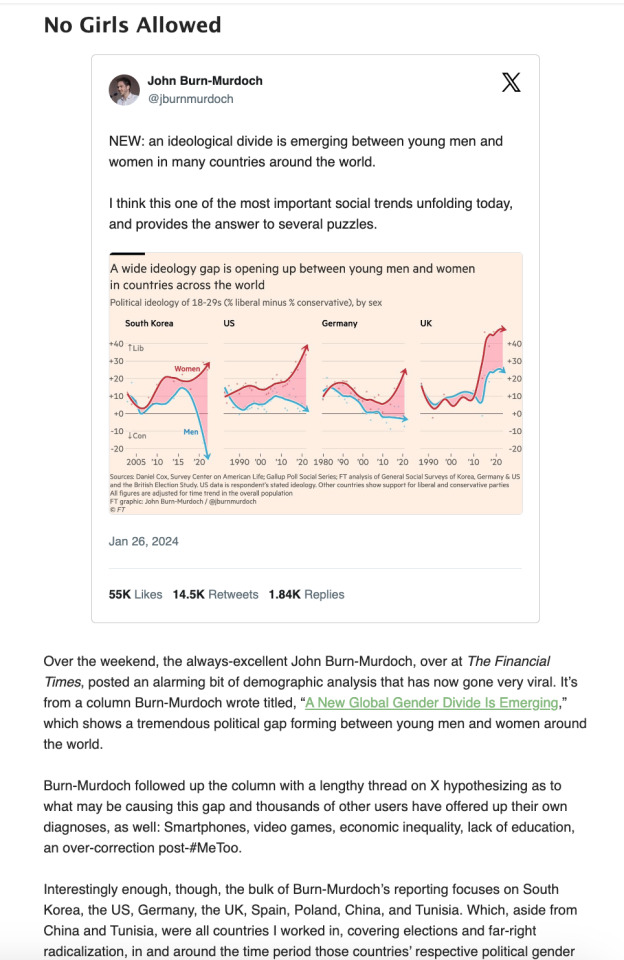
Most mar a garbage day is megirta (egybol ossze is omlott a site)
Over the weekend, the always-excellent John Burn-Murdoch, over at The Financial Times, posted an alarming bit of demographic analysis that has now gone very viral. It’s from a column Burn-Murdoch wrote titled, “A New Global Gender Divide Is Emerging,” which shows a tremendous political gap forming between young men and women around the world.
Burn-Murdoch followed up the column with a lengthy thread on X hypothesizing as to what may be causing this gap and thousands of other users have offered up their own diagnoses, as well: Smartphones, video games, economic inequality, lack of education, an over-correction post-#MeToo.
Interestingly enough, though, the bulk of Burn-Murdoch’s reporting focuses on South Korea, the US, Germany, the UK, Spain, Poland, China, and Tunisia. Which, aside from China and Tunisia, were all countries I worked in, covering elections and far-right radicalization, in and around the time period those countries’ respective political gender gaps began widening. I’m not saying I have a tremendously in-depth understanding of, say, Polish toxic masculinity, but I did spend several days there following around white nationalist rappers and Catholic fundamentalist football fans. And, in South Korea, I worked on a project about radical feminists and their activism against the country’s equivalent of 4chan, Ilbe Storehouse.
In fact, between 2015-2019, I visited over 20 countries, essentially asking the same question: Where do bad men here hangout online? Which has given me a near-encyclopedic directory in my head, unfortunately, of international 4chan knock-offs. In Spain, it’s a car forum that doxxes rape victims called ForoCoches. In France, it’s a gaming forum that organized rallies for Marine Le Pen called Jeux Video. In Japan, it’s 2channel. In Brazil, it’s Dogolachan. And most, if not all, of these spaces pre-date any sort of modern social movement like #MeToo — or even the invention of the smartphone.
But the mainstream acceptance of the culture from these sites is new. Though I don’t actually think the mystery of “why now?” is that much of a mystery. While working in Europe, I came to understand that these sites and their culture war campaigns like Gamergate were a sort of emerging form of digital hooliganism. Nothing they were doing was new, but their understanding how to network online was novel. And in places like the UK, it actually became more and more common in the late-2010s to see Pepe the Frog cosplayers marching alongside far-right football clubs. In the US, we don’t have the same sports culture, but the end result has been the same. The nerds and the jocks eventually aligned in the streets. The anime nazis were simply early adopters and the tough guys with guns and zip ties just needed time to adapt to new technology. And, unlike the pre-internet age, unmoderated large social platforms give them an infinitely-scalable recruitment radius. They don’t have to hide in backrooms anymore.
Much of the digital playbook fueling this recruitment for our new(ish) international masculinist movement was created by ISIS, the true early adopters for this sort of thing. Though it took about a decade for the West to really embrace it. But nowadays, it is not uncommon to see trad accounts sharing memes about “motherhood,” that are pretty much identical to the Disney Princess photoshops ISIS brides would post on Tumblr to advertise their new life in Syria. And, even more darkly, just this week, a Trump supporter in Pennsylvania beheaded his father and uploaded it to YouTube, in a video where he ranted about the woke left and President Biden. Online extremism is a flat circle.
The biggest similarity, though, is in what I can cultural encoding. For ISIS, this was about constantly labeling everything that threatened their influence as a symptom of the decadent, secular West.
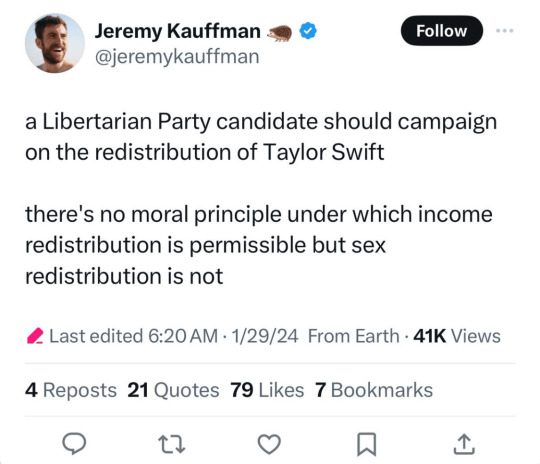
(X.com/jeremykauffman)
Taylor Swift, an extremely affluent blonde, blue-eyed white woman who writes country-inflected pop music and is dating a football player headed for the Super Bowl. She should be a resounding victory for these guys. Doesn’t get more American than that. But due to an actually very funny glitch in how they see the world, she’s actually a huge threat.
Pop culture, according to the right wing, should be frivolous. Because before the internet, it was something sold to girls by corporations run by powerful men. Famous pop stars through the ages, like Frank Sinatra, America’s first Justin Bieber, or The Beatles, the One Direction of their time, would be canonized as Great by Serious Men after history had forgotten they rocketed to success as their generation’s Tumblr Sexymen. But from the 2000s onward, thanks to an increasingly powerful digital public square, young women and people of color were able to have more influence in mainstream culture and also accumulate more financial power from it. And after Barack Obama’s 2008 presidential campaign was able to connect this new form of pop influence to both liberal progressive politics and, also, social media, well, conservatives realized they had to catch up and fast. And the fastest way to do that is to try and smash the whole thing by dismissing it as feminine.
Pop music? It’s for girls. Social media? It’s for girls. Democrats? Girls. Taylor Swift? Girls and also a government psyop. But this line of thinking has no limit. It poisons everything. If Swift manages to make it to the Super Bowl, well, that has to become feminine too. And at a certain point, the whole thing falls apart because, honestly, you just sound like an insane loser.
39 notes
·
View notes
Text
"Musk’s stake in Tesla comprises the lion’s share of his wealth. He can laugh off a few protesters, but if consumers launch a sustained boycott, both Musk and his car company could find themselves in dire straits. Tesla was already in a precarious position before Musk’s flirtation with the far right turned into an all-out embrace. Nosediving sales would be an incapacitating blow.
…consumer rejection could be uniquely devastating to Tesla right now. The company’s vulnerability stems from its eye-popping market valuation, which was $1.15 trillion as of Friday. To put that figure in perspective, it is five times as high as Toyota’s, 25 times as high as General Motors’, and 31 times as high as Ford’s. (Each of these companies builds vastly more vehicles.) Equally stunning is Tesla’s astronomical price-to-earnings ratio of 181, which assumes mind-boggling profit growth. For years, Tesla’s lofty stock price has provided a notable advantage over competitors, since each share offered as compensation to employees is so valuable.
Tesla’s soaring valuation has been driven primarily by two forces: first, historically scorching sales growth across its three core markets of North America, Europe, and China; and second, investor belief that Musk is a genius who can conjure lucrative innovations out of thin air. (Although Musk has described Tesla as a diversified “chain of startups,” automobile sales accounted for about 85 percent of its revenue in 2023. So it’s kind of just a car company.) Tesla’s media events are a circus, with Musk playing ringleader as he unveils futuristic products like humanoid robots, self-driven taxis, and even an Art Deco bus (which did look pretty cool, admittedly).
But even before Musk’s pivot to the hard right, Tesla was under mounting pressure. The company’s global vehicle sales fell in 2024, the first such decline in its history, and its profit margins have been shrinking. The Cybertruck, Tesla’s first new product in years, has flopped, and the company’s existing lineup is growing stale, with only minor updates in the works.
…
With Tesla’s fundamentals looking shaky, the company’s elevated stock price becomes increasingly dependent on the belief that Musk the magician can deliver wildly creative new products. That image is fading. Last year, Tesla rented Warner Bros. Studios, in Burbank, California, to unveil the “Cybercab,” a vehicle that, according to Musk, will begin offering robotaxi service in Austin this summer. The market response to the Cybercab has been tepid; many observers noted that the company’s CEO has consistently failed to meet previous deadlines to deliver self-driving technology, and that Waymo, which already offers robotaxi service in several cities, seems far ahead.
…
Things might already be headed in that direction. In Europe, Tesla’s January sales collapsed by at least 40 percent in countries including France, Spain, Norway, and Germany. Musk’s sullied reputation appears to be a factor: A pollster found a double-digit surge in Swedes expressing a negative view of Tesla following Trump’s inauguration, at which Musk was widely condemned for giving a Hitler salute. As the drop in European revenue raised eyebrows last week, Tesla stock shed 6 percent of its value, and it dropped a further 8 percent over the past two days.
American sales figures are still trickling in, but Tesla has cause to worry in its home market too. In California, a left-leaning state with the largest EV market in the nation, Tesla sales fell 8 percent in the fourth quarter of 2024.
A North American sales collapse would be a disaster for Tesla shareholders, starting with Musk himself, who owns around 13 percent of the company. “Musk’s stake in Tesla is partly pledged for loans that he depends on for cash,” Niedermeyer said. If the value of his Tesla stock falls, lenders could force Musk to sell additional shares. Many Tesla investors (and his fan base) may see that as a vote of no confidence in the company’s future, prompting them to sell shares—triggering a full-on Wall Street rout, with Tesla’s stock crashing in value."
Source
7 notes
·
View notes
Text
In the early morning hours of New Year’s Day, a 42-year-old U.S. Army veteran named Shamsud-Din Jabbar drove through a crowd of revelers in the French Quarter of New Orleans, killing at least 14 and injuring dozens more. Jabbar had an Islamic State flag on the rented vehicle and reportedly recorded a video pledging his allegiance to the jihadi group.
The FBI is likely conducting an assessment of Jabbar’s electronics to see what the digital forensics reveal: what kind of Islamic State propaganda was he imbibing; how frequently was he reading Islamic State posts; did he download guides to make improvised explosive devices, or IEDs; which social media platforms did he visit; and was he in touch with any actual Islamic State operatives who may have served as a cyber-coach or virtual entrepreneur in the attack.
In the past year, almost all thwarted and successful Islamic State external operations—meaning attacks outside the perimeter of the group’s various provinces—have been inspired by the group, rather than enabled or directed by it. This is a stunning feat: The Islamic State has effectively leveraged its brand worldwide to inspire violence and carnage far away from the territories it controls, without even extending basic support to the attackers.
This underscores the crucial role of technologies such as social media and communication platforms in providing access to radicalizing content, as well as the knowledge and technical know-how necessary to orchestrate attacks. It also implies, however, that many such plots depend on rudimentary, low-tech methods—such as vehicle ramming—that capitalize on the simplicity and brutal effectiveness of forceful tactics.
So, how can these attacks be thwarted, and what are ways to stem the effective franchising of the Islamic State worldwide?
The adoption of advanced technology by terrorists—from IEDs to unmanned aerial vehicles—and the continued, highly successful use of simple attack measures—from vehicle ramming to stabbing attacks—indicate the need for a more nuanced understanding of why terrorists opt for certain technologies to commit attacks over others. In a case from last November, a far-right extremist in the United States planned to attack an energy facility substation with a drone rigged with explosives—a stark contrast with what happened in New Orleans.
Vehicle ramming attacks, requiring little to no planning, have become one of the most successful tactics in Islamic State-inspired terrorism due to a combination of practical and ideological factors. They have been used in attacks inspired and enabled by the group worldwide, including in Barcelona, Berlin, London, New York City, Nice, and Stockholm. Vehicle ramming attacks are more likely to succeed because they are incredibly difficult to detect in the planning phase and are equally hard and resource-intensive to mitigate.
In terms of accessibility, cars are readily available, and through rentals and vehicle-sharing platforms, only limited resources are necessary to conduct such an attack. In what the FBI says is merely a coincidence, the New Orleans attacker and a U.S. Army Special Forces soldier who shot and killed himself before the Tesla Cybertruck he was in exploded on Jan. 1 in Las Vegas both used the peer-to-peer rental app Turo to obtain their vehicles.
Additionally, the barrier to entry is low and only requires a driver’s license. The symbolic aspect of vehicle ramming attacks is also important: An everyday utility object can cause mass carnage at any moment, with almost no preparation necessary. These attacks are not unique to jihadi groups. A far-right extremist used a vehicle during the 2017 Unite the Right rally in Charlottesville, Virginia, to ram into a crowd of counter-protesters, killing one. Just weeks ago, a Saudi national living in Germany, motivated by a strange brew of anti-Islamic and far-right ideas, used a car to attack a Christmas market southwest of Berlin.
The Islamic State has long relied on inspiring its supporters to conduct vehicle attacks, following an explicit admonition to do so by its former No. 2, Abu Mohammad al-Adnani, who once exhorted Islamic State supporters to conduct attacks against Westerners with any means at their disposal. “Smash his head with a rock, or slaughter him with a knife, or run him over with your car, or throw him down from a high place, or choke him, or poison him,” Adnani urged more than a decade ago. These brute-force tactics remain highly successful and hard to detect in the planning stages.
Counterterrorism can be a thankless profession. When plots are disrupted or terrorist cells rolled up, it may make the news cycle momentarily, but few people give much thought to what could have been if an attack had succeeded. And the FBI, CIA, and other agencies focused on counterterrorism have a legitimately impressive record in the generational struggle against groups such as al Qaeda, the Islamic State, and their various affiliates, franchises, and regional branches.
But as the Irish Republican Army stated publicly after nearly killing British Prime Minister Margaret Thatcher in 1984, “We only have to be lucky once. You have to be lucky always.” It also means that counterterrorism authorities need to allocate resources where they believe the threat is the greatest, which sometimes leads them to become fixated on the “bright, shiny object” or the potential black swan event. This means a great deal of focus on terrorists using drones for attacks or attempting to deploy chemical or biological weapons. But the more quotidian attacks, like that in New Orleans, can still be highly lethal and nearly impossible to deter or defend against.
Constructing steel bollards or other objects that help harden soft targets is one method used by counterterrorism practitioners to secure public event spaces. In New Orleans, the bollard system was being repaired in preparation for next month’s Super Bowl. But even this shows that our societies are always adapting or responding to terrorism, even as our politicians like to trot out the fallacy that altering our lives in any way is “letting the terrorists win.” Still removing one’s shoes in the security line at the airport more than two decades after the infamous shoe bomber attack is a clear example of this. On the contrary, hardening soft targets, with either protective barriers or an increased police presence, is merely a recognition that the threat is real and, as a society, we intend to stand up against it.
There is no silver bullet solution to managing the threat posed by terrorism. After all, it is a tactic and as such cannot be defeated in the traditional sense, as if it were an army or a nation-state. Sound counterterrorism means kinetic measures such as drone strikes and special operations raids but also a comprehensive approach to dealing with root causes and grievances, whether those are socioeconomic, religious, ethnonationalist, or otherwise. In many ways, the Islamic State’s model of outsourcing its terrorism in the West to lone actors with a litany of grievances is the group’s realization of its long-sought playbook. It also makes focusing on root causes more important. In the case of Jabbar, reporting suggests that he struggled, like many others, with reintegrating into civilian life after leaving the military.
Counterterrorism in the modern age must be viewed through a broad, multifaceted lens, addressing both high-tech and low-tech threats in tandem. While the proliferation of advanced technologies—such as drones, encrypted communications, and bombs—requires a sophisticated and coordinated response, we must not overlook the enduring threat posed by more primitive methods such as vehicle ramming attacks and stabbings. Consequently, a comprehensive counterterrorism strategy means dismantling the technological infrastructure that enables terrorist groups to communicate and operate across borders while simultaneously fortifying the physical and societal barriers that mitigate the risk of simpler, brute-force tactics.
Only through a balanced approach that spans the full spectrum of technology used in attacks can we ensure the safety and resilience of our communities against the ever-evolving, blinking-red landscape of terrorism. As the Islamic State ramps up its operations overseas, taking advantage of power vacuums from Syria to Somalia, it will also accelerate its propaganda and media operations, leading to more of its followers seeking to conduct attacks in its name.
The Islamic State may have fallen off the front page of the newspaper, overshadowed by Russia’s war in Ukraine and Israel’s response to the Oct. 7, 2023, Hamas attack, but it remains stubbornly resilient and will prove to be a day-one issue for the Trump administration.
7 notes
·
View notes
Text

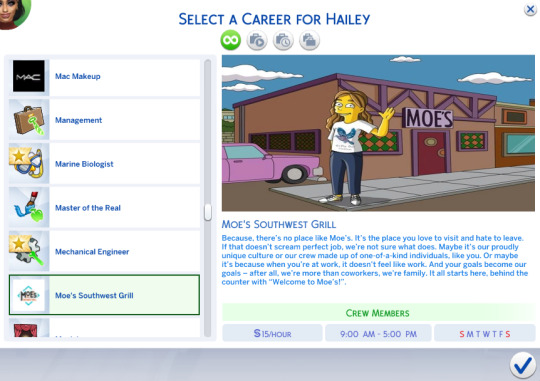


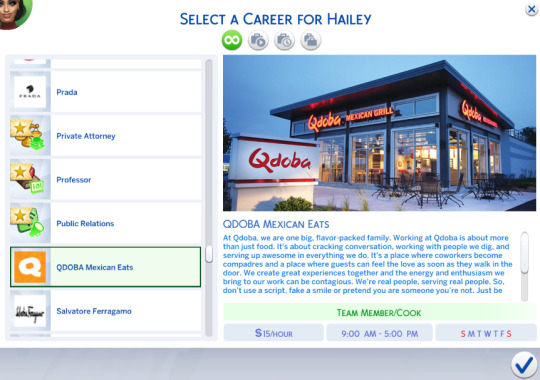
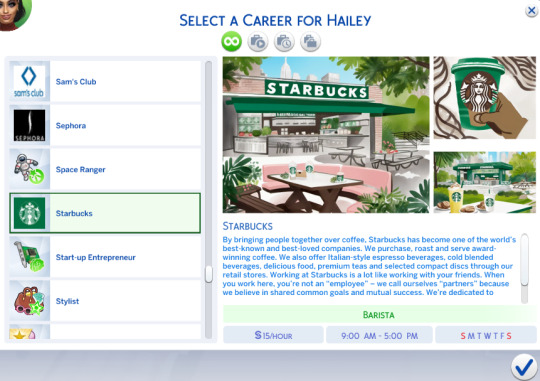
🦄The Sims 4🦄
🍵Restaurant Bundle🍵
💕Early Release 4.26.2024💕
Chipotle Mexican Grill
Chipotle Mexican Grill, Inc. (NYSE: CMG) is cultivating a better world by serving responsibly sourced, classically-cooked, real food with wholesome ingredients without artificial colors, flavors or preservatives. Chipotle had over 3,400 restaurants as of December 31, 2023, in the United States, Canada, the United Kingdom, France and Germany and is the only restaurant company of its size that owns and operates all its restaurants in North America and Europe. Chipotle is ranked on the Fortune 500 and is recognized on Fortune's Most Admired Companies 2024 list and Time Magazine's Most Influential Companies. With over 115,000 employees passionate about providing a great guest experience, Chipotle is a longtime leader and innovator in the food industry. Chipotle is committed to making its food more accessible to everyone while continuing to be a brand with a demonstrated purpose as it leads the way in digital, technology and sustainable business practices.
Crew Member
Restaurant Prep/Grill
Service Leader
KITCHEN LEADER
Kitchen/Service Manager
Manager
Allow Teen
Allow Young Adult
Allow Adult
Allow Elder
Moe's Southwest Grill
Because, there’s no place like Moe’s. It’s the place you love to visit and hate to leave. If that doesn’t scream perfect job, we’re not sure what does. Maybe it’s our proudly unique culture or our crew made up of one-of-a-kind individuals, like you. Or maybe it’s because when you’re at work, it doesn’t feel like work. And your goals become our goals – after all, we’re more than coworkers, we’re family. It all starts here, behind the counter with “Welcome to Moe’s!”.
Crew Members
Shift Lead
Shift Manager
Assistant Manager
General Manager
Allow Teen
Allow Young Adult
Allow Adult
Allow Elder
Panera Bread
We are Panera Bread and we believe that good food, the food you can feel good about, can bring out the best in all of us. Food served in a warm, welcoming environment, by people who care. To us, that’s good eating and that’s why we’re here. We are inspired by our mission and purpose in everything we do: “One Panera for a Healthier and Happier World.” We believe in serving delicious, freshly prepared, clean dishes made with carefully selected ingredients that we would be proud to serve our own families. Our menu, crafted by chefs and bakers, features classic, comforting dishes, each with an intriguing twist. We respect our planet and take measures to lessen our impacts. We believe in treating people with warmth, kindness, and respect, whether it’s a guest in our cafe or one of our associates. We believe in helping our local communities, especially in times of need.
Cashiers
Salad and Sandwich Maker
Shift Supervisor
Team Manager
Baker
Allow Teen
Allow Young Adult
Allow Adult
Allow Elder
Panda Express
Panda Restaurant Group, the world leader in Asian dining experiences and parent company of Panda Express, Panda Inn, and Hibachi-San, is dedicated to becoming a world leader in people development. We are family-owned and operated with over 2,500 locations worldwide and more than 48,000 associates. Our mission is to deliver exceptional Asian dining experiences by building an organization where people are inspired to better their lives. Our vision is to be recognized as a world leader in people development to become loved by our guests. What makes Panda a great place to work is our rich and purpose-driven culture that focuses on values that promote growth and progress for our people and business. This is the foundation created by our Co-Founders and Co-CEOs, Andrew and Peggy Cherng, to help all members of the Panda family excel not only in their professional lives, but also their personal lives. We do everything with intentionality and a clear mission that prioritizes people over profit. Our values drive the foundation upon which Panda Restaurant Group operates: Proactive, Respect/Win-Win, Growth, Great Operations, and Giving.
Kitchen Team
Shift Leader/Cook
Assistant Manager
Store Manager
Allow Teen
Allow Young Adult
Allow Adult
Allow Elder
QDOBA Mexican Eats
At Qdoba, we are one big, flavor-packed family. Working at Qdoba is about more than just food. It's about cracking conversation, working with people we dig, and serving up awesome in everything we do. It's a place where coworkers become compadres and a place where guests can feel the love as soon as they walk in the door. We create great experiences together and the energy and enthusiasm we bring to our work can be contagious. We’re real people, serving real people. So, don’t use a script, fake a smile or pretend you are someone you’re not. Just be you.
Team Member/Cook
Line Server
Shift Leader
Assistant Manager
Allow Teen
Allow Young Adult
Allow Adult
Allow Elder
Starbucks
By bringing people together over coffee, Starbucks has become one of the world’s best-known and best-loved companies. We purchase, roast and serve award-winning coffee. We also offer Italian-style espresso beverages, cold blended beverages, delicious food, premium teas and selected compact discs through our retail stores. Working at Starbucks is a lot like working with your friends. When you work here, you’re not an “employee” – we call ourselves “partners” because we believe in shared common goals and mutual success. We’re dedicated to serving ethically sourced coffee, caring for the environment and giving back to the communities where we do business.
Barista
Shift Manager
Supervisor
Allow Teen
Allow Young Adult
Allow Adult
Allow Elder
DOWNLOAD NOW
#gaming#the sims 4#the sims university#the sims 4 cc#celebrities#sims 4#the sims 4 mods#sims 4 mods#nicki minaj#pink#sims 4 career#starbucks#starbucks moodboard#starbucks boycott#starbucks coffee#starbucks cup#mcdonalds#starbucks barista#pizza hut#boycotting#coca cola#boycott israel#panera#panera bread#chipotle grill
35 notes
·
View notes
Text

Ok, art time: I spilled tea on my laptop and while mopping it up with the sleeve of my hoodie I accidentally created this folder and renamed it. I call this work of art "Tea Folder". I'm auctioning it off starting at 2000$.
Please refrain from saying you "could have done this". You didn't! This is my genius creative expression! Certainly the fact that I am not a famous artist won't impact your opinion of my art in any meaningful way?
This is a poem, by the way, I simply avoided the unnecessary formal aspects that hindered traditional poets from fully expressing themselves. Also it's completely unique! One of a kind!
And it's super deep because it's a testament to such a unique moment in time. It's so simple, yet it says so much. It looks like a keyboard smash, which usually expresses intense emotions, yet, paradoxically, here it expresses no emotion at all, challenging the viewer to examine how random combinations of letters make them feel. Really it's a subversion of the norms of internet culture. If a random accident can produce a keyboard smash, then what does language even mean? Wow I'm so deep. You wouldn't have seen this coming, would you? No, you didn't think of that. I did.
---
c[LOUD]s of w[INK]s is a mixed media artist based in Germany. She is interested in the intersections between modern technology and everyday life. Her challenging and provocative art frequently explores novel ways to conceptualize digital spaces. She was listed in "40 daftest female artists under 40" and her work has been exhibited by all of her wealthy friends. She took a lot of social anthropology classes in college and knows which buzzwords to use to impress upper middle class airheads who think they're sophisticated.
29 notes
·
View notes
Text
For decades, Britain’s Left-wing elite has looked at Europe’s high-spending social model with a degree of awe.
France, Germany and Scandinavia have long been viewed, perhaps through rose-tinted spectacles, as examples of what the UK could be if governments were not so tight-fisted.
Under Sir Keir Starmer, Labour is determined to give the country a much bigger state. Official projections published alongside the Budget last month show government spending will settle at around 45pc of GDP.
Spending has never been sustained at these levels before, only reaching such highs briefly in the nation’s worst moments – including the pandemic, the financial crisis and the 1970s oil shocks.
So at last the UK has a chance of becoming the high-spending social democracy of Labour dreams.
It is unfortunate, then, that this is the moment Christine Lagarde has chosen to issue an extraordinarily vivid warning: Europe’s social models are utterly unsustainable.
Weak and uncompetitive economies risk running out of money to fund their sprawling welfare states unless they can reverse decades of relative decline and emulate America’s runaway success in tech, the president of the European Central Bank (ECB) cautioned.
“Our productivity growth in Europe is progressively slowing, which means that our ability to generate income is diminishing. If left unchecked, we will face a future of lower tax revenues and higher debt ratios,” she said in a speech in Paris.
“We face a rising old-age dependency ratio which will drive up public spending on pensions. And it is estimated that governments will need to spend in excess of €1 trillion (£836bn) a year to meet our investment needs for climate change, innovation and defence.
“If we cannot raise productivity, we risk having fewer resources for social spending.”
Those pressures are only going to mount. Pensions, for instance, are becoming ever more expensive. More than one-fifth of the populations of Spain, Germany and France are now aged over-65. In Italy, almost one-quarter have reached that age. Two decades ago, none had more than 20pc in the cohort.
Projections from the United Nations show even more stark increases to come. In Italy, for instance, more than one-third of the population will be aged 65 or older by 2040.
In Britain, not only is the share of pensioners rising – despite increases to the state pension age – but the generosity of the benefits they receive is also increasing.
The triple lock means the state pension rises by the highest of inflation, wages or 2.5pc each year, meaning benefits paid out in old age are, over time, guaranteed to rise more quickly than the incomes of the people whose taxes cover the cost. Adding to that is the cost of healthcare for those pensioners.
As Lagarde put it: “We face and will continue to face growing expenditure arising from a changing security environment, ageing populations and the climate transition.”
Cutting back any of those benefits is appallingly hard, as successive British governments have found. Not unsurprisingly, voters whose taxes paid for previous generations of pensioners find it galling to be asked to receive less themselves.
Similarly in France, Emmanuel Macron faced widespread protests against his plans to raise the pension age. Marine Le Pen’s National Rally made big gains in this year’s general election, in part on promises to reverse the increase.
Costs are also growing for other age groups, with more generous childcare subsidies on offer in Britain, as well as a rising population of working-age benefits claimants.
Europe is ‘trailing behind’
If Europeans want to keep on enjoying such largesse, they need to find a way to pay the bills, says Lagarde.
“Europe is under pressure. The rapid pace of technological change triggered by the digital revolution has left us trailing behind,” said the ECB president and former managing director of the International Monetary Fund.
“We need to adapt quickly to a changing geopolitical environment and regain lost ground in competitiveness and innovation. Failure to do so could jeopardise our ability to generate the wealth needed to sustain our economic and social model, which the vast majority of Europeans nevertheless hold dear.”
While the US economy roared back from Covid, Europe’s recovery was distinctly underwhelming, with Germany effectively failing to grow at all from its 2019 level. But the problem is not just a lockdown after-effect.
Over the past 20 years, productivity has grown twice as fast in the US as in the eurozone. Output for every hour worked has climbed by more than one-quarter in America compared to less than 13pc in the single currency area.
In Britain the situation is even worse, with productivity up by less than one-tenth.
The world’s largest companies illustrate the problem. By market capitalisation, the biggest five – each worth more than $2 trillion – are all American, led by Apple. All are also tech companies – chip-maker Nvidia, Microsoft, Google-owner Alphabet, and Amazon.
In sixth place, at a mere $1.8 trillion, is the first non-American entry, Saudi Aramco, the state oil company.
Most of the top 20 are American. The first European company is in 25th place – Denmark’s Novo Nordisk, famed for its manufacture of Ozempic and Wegovy, and worth the best part of half a trillion dollars.
The biggest European tech company is SAP, a relatively unsung German titan of business technology, and the 37th-largest listed company globally.
The industries in which Europe was traditionally a world leader are under growing threat.
Germany’s car industry is struggling to compete with cheap electric vehicles from China and fashion and luxury groups are at risk from tariffs if president-elect Donald Trump makes good on his campaign policy to impose border taxes of 10pc or even 20pc on imported goods.
LVMH, the 34th-biggest company and star of French industry, ranks highly on Morgan Stanley’s list of businesses which are exposed to US tariffs, because of the large share of products which the luxuries group sells over the Atlantic.
It is also exposed to any slowdown in trade with China, showing how exposed Europe has become to geopolitical tensions.
Lagarde says the Continent risks a “middle-technology trap”.
“We are specialised in technologies that were mostly developed in the last century. Only four of the world’s top 50 tech companies are European,” she said.
“Unlike in the past, Europe is no longer at the forefront of progress. Our productivity growth – the key factor driving our long-term prosperity – is diverging from the US.”
On top of that come trade wars, and the cost of military wars with Russia the most immediate threat, for which the continent is under-prepared.
As Lagarde notes, it was only wealth that generated the taxes to pay for Europe’s welfare states in the first place.
The sun is setting on European-style welfarism. Sir Keir must take note – growth has to come first.
10 notes
·
View notes
Text
Brazilian companies among the most critical of workforce quality
Brazil ranks seventh in global study on private sector’s struggle to find skilled professionals

Brazilian companies are among those most vocal globally about struggling to find skilled professionals. This sentiment is echoed by 81% of businesses, placing Brazil seventh among 42 countries and territories participating this year in the Talent Shortage survey, conducted by ManpowerGroup, a workforce solutions organization, and reviewed exclusively by Valor.
Germany (86%), Israel (85%), and Portugal (84%) top the ranking. The global average is 74%.
According to Wilma Dal Col, Chief Human Resources Officer at ManpowerGroup, multiple factors contribute to the high level of complaints from Brazilian companies regarding the workforce. She explains that the job market is undergoing “exponential” technological advancement, which affects the perception of the requirements for tasks and learning.
“The academic world does not keep pace with the job market, which is intensely experiencing digital evolution and transformation,” she said.
Continue reading.
3 notes
·
View notes
Text



I'd like to go on a little rant to thank everybody :)
Oh dang-it I might be too tired.
The company I work for faces a bit of economic downturn, that results in me having a workload of 3 people in one position and one pay. To combat inflation, and to support myself and my best friend, I regularly take in Tarot card clients. I never studied art before, I have no art teacher, and my background is foreign languages and English literature (and I sucked at school). I am quite surprised by the support and comments I get on Tumblr, because I don't think I am that good. Thank you all. :)
The reason I got into art was My best friend. She is a history professor, her specialty is in WWII and military/technological systems comparisons between the Germany and the Soviet bloc. She has been a visiting scholar to the University of Moscow. Since the war went down, her grants all dried up, and she has to pay out of her own pockets to continue such researches. That's part of the reason why we have no savings whatsoever.
She got me interested in WWII a few years ago and I attempted to sketch wartime personalities. Here I have Marshal Zhukov, Vasilevskiy and Walter Model. I realized I could capture faces pretty decently, with struggles, of course.
Still everyday I draw is a struggle; my anatomy knowledge sucks, my perspectives are crooked, I use an old ass Photoshop CS2 to do everything because sb gave me that program for free. I don't know how to install brushes on that so it's terrible. I use a second hand year 2000-ish digital tablet because sb sold it for cheap. I am grateful of every like and reblog and my friend who "discovered" my talent (or lack thereof).
OK long rant over~~~
27 notes
·
View notes
Text
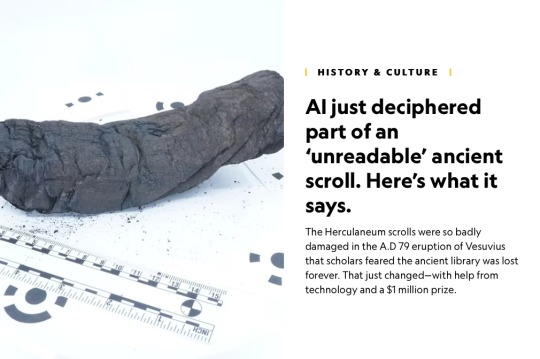
AI Helps Decipher First Text of Unreadable Ancient Herculaneum Scroll
With the help of artificial intelligence, a colorful ancient Greek word has emerged from a text damaged in the A.D. 79 eruption of Vesuvius, marking an important milestone in the centuries-long attempt to decipher an unparalleled ancient library assumed to be lost forever.
That word, πορφύραc, referring to purple dye or purple-colored clothes—a color closely associated with royalty and power—comes from one of the famed Herculaneum scrolls discovered by workers digging up the ancient town of Herculaneum near Pompeii in 1752. The roughly 1,800 unearthed papyrus scrolls—believed to contain literary and philosophical works from the first and second centuries B.C.—had been reduced to brittle, charred lumps by the heat and gasses of the eruption. And those carbonized scrolls that workers didn’t throw away more than 250 years ago have largely languished since then in storerooms, written off as unreadable curiosities.
Technological developments over the past two decades have helped researchers get closer to being able to “read” the fragile scrolls. But only the very recent acceleration of artificial intelligence and computing have finally made it possible to begin unlocking their secrets—all without opening them.
Researchers backed by Silicon Valley investors put decoding efforts into overdrive this spring by launching the Vesuvius Challenge.The global competition offers prize money for significant benchmarks in coaxing the long-lost Herculaneum texts from their carbonized husks by applying machine learning techniques to digital images of the scrolls.
The challenge awarded its first installment of the $1 million total prize pot today to two competitors—an American college student and an Egyptian graduate student in Germany—who separately revealed at least 10 letters from a single small area of an intact scroll, including the colorful and complete “πορφύραc.”
With this achievement, scientists say they are now one step closer to being able to read full passages and—someday—entire scrolls that had previously been considered unreadable.

“We knew if we could read just one [scroll], then all the other ones would be available with the same method or some augmented method,” says Brent Seales, a computer scientist at the University of Kentucky who’s been trying to decode the Herculaneum scrolls for the last 20 years and leads the university’s Digital Restoration Initiative. “And this is a big moment because we are now proving not just to ourselves but to the entire global community that the scrolls are readable.”
Reading the Herculaneum scrolls, he says, will help connect us to the past in “astounding” ways.
“These people were humans just like us,” Seales adds. “These were intellectuals. Their thoughts were complex. It says something about what it means to be human to be able to read a thought that came directly from a single person or a group of people so long ago.”
An era ‘shrouded in mystery’
Since the mid-1700s, people have made various attempts at reading some of the less damaged scrolls from Herculaneum. One method involved cutting the scrolls in half and scraping away layers one at a time to see the text inside; another involved slowly unwinding the scrolls with a specially built machine. Though these 18th and 19th century efforts did allow conservators to copy down some of the words inside, they often damaged—or, worse, totally destroyed—many of the scrolls in the process.
Many of the previously opened scrolls revealed Greek philosophical texts, including some by philosophers Epicurus and Philodemus. But, by and large, the contents of the unopened scrolls are unknown—and that’s part of what makes the quest to open them so enticing. On top of that, the Herculaneum scrolls, discovered in a villa likely belonging to Julius Caesar’s father-in-law, represent the largest known surviving library from classical antiquity. Revealing their texts would be a boon to historians and to our collective understanding of the past.
“Some 95 percent of the material from the classical period is lost, so we just don’t have anything, and yet we know it was one of the most important philosophical periods of humanity,” says Seales. “It’s an era shrouded in mystery for which we’ve lost most of the material.”




Between 500 and 600 carbonized scrolls from Herculaneum—kept in museum, university and national collections in England, France and Italy—remain unopened, though the exact figure is hard to estimate because many are fragmented. The scrolls are extremely brittle, which means physically unrolling them is not a viable option. “If you drop one, it would shatter like glass,” Seales explains.
Technological advancements since the early 2000s have helped researchers overcome this hurdle, including using CT scans to make 3D images of ancient scrolls. From there, the Digital Restoration Initiative team developed software that could “virtually unwrap” the 3D images to produce flattened segments. This method enabled them to read previously hidden text from the Ein Gedi scroll, a charred and fragmented scroll from the Middle East dated to the third or fourth century A.D.
When researchers tried to use this method to read the scrolls carbonized by Vesuvius, however, they ran into another roadblock. The ink used on the Ein Gedi scroll contained metal, which meant the letters were visible on the CT scan. The Herculaneum scrolls, by contrast, were written with carbon-based ink, which, to the human eye, makes the symbols indistinguishable from the carbonized papyrus on the CT scans.
Undeterred, researchers wondered if higher-resolution scans of the scrolls produced by a particle accelerator could provide an even more detailed view of the carbonized papyrus. Sure enough, at very high resolutions, the scans revealed visible areas where the ink slightly altered the shape and texture of the papyrus fibers. “The carbon-based ink sort of fills in the holes that are the grid of the papyrus—it coats them and makes them a little thicker,” says Seales.
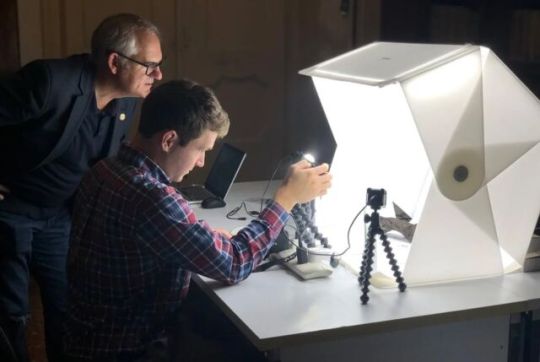
Seales and his Digital Restoration Initiative colleagues then developed and trained a machine learning model to detect these subtle differences in the carbonized papyrus surfaces. But to take the project any further, they needed human beings to help. That’s where the Vesuvius Challenge comes in. Hoping to harness the collective power of citizen scientists around the world, Seales teamed up with Silicon Valley investors and put his team’s data, code, and methods online for anyone to access. The challenge’s pitch? After 275 years, the puzzle of the Herculaneum scrolls has been reduced to a software problem—one that anyone, anywhere with access to a computer could, in theory, contribute to solving.
In March, the challenge team released thousands of 3D images of two rolled-up scrolls, as well as a machine-learning algorithm trained to detect the invisible letters and symbols written on the layers of carbonized papyrus. They also offered $1 million in prize money to incentivize participants to build upon the AI technology and, ultimately, speed up the deciphering.
Two competitors extracted the new snippet of text separately: Luke Farritor, a 21-year-old undergraduate at the University of Nebraska-Lincoln, and Youssef Nader, a 26-year-old doctoral student at Freie Universität Berlin. Because Farritor revealed the text first, he wins $40,000, while Nader wins $10,000. Papyrologists also authenticated their findings.
Still on the line is the $700,000 grand prize, which will go to the first person or team that can reveal at least four separate passages from the two scrolls. Each passage must contain at least 140 characters of continuous text, with no more than 15 percent of the characters missing or illegible, by the end of 2023.
Citizen scientists can find everything they need online, from the history of the scrolls themselves to downloadable data, algorithms, and tutorials. And while the contest is open to anyone, it’s technical work that’s so far mostly attracted computer scientists who are already well-versed in machine learning. Competitors are helping advance the project forward by virtually unwrapping additional sections of scrolls via software and methods developed by Seales; they’re also working to improve the machine learning model by providing it with additional training examples from the newly unwrapped digital segments of papyrus.



‘The scrolls are readable’
The competitors—an estimated 1,500 to 2,000 of them in total, according to Seales—have done their part. In just six months, they’ve made huge strides toward solving this puzzle, including the three full lines of text that Farritor and Nader recently revealed. “We’ve seen 10 or 20 person years of work from these competitors,” says Seales.
So, what’s motivating the contestants to volunteer hours and hours of their time toward the project? The prize money is a big factor (both Nader and Farritor say they want to win the grand prize) but, on top of that, some competitors are simply intrigued by the scrolls themselves. “When things were a bit frustrating and things were not working, I felt like I was unable to give up because I was just too curious—I really need to know what’s going on here,” says Nader.
There’s also the allure of working on a project backed by Silicon Valley entrepreneurs and investors. Former GitHub CEO Nat Friedman launched the contest, along with venture capitalist Daniel Gross; other startup founders and investors also chipped in prize money. “There’s kind of this Silicon Valley prestige,” says Farritor, who spent the summer interning at SpaceX.
From here, the machine learning model should continue to improve even more and reveal additional letters until, ideally, researchers will be able to decipher all of the Herculaneum scrolls. These efforts could pave the way for future excavation work at Herculaneum, where some experts believe even more scrolls are still buried.
“Some people might think, ‘What are you going to all that trouble for?’ but I don’t believe that,” says Seales. “This is an amazing period in human history. We’re talking about more works from that period. Yeah, I want more, I want it all.”
By Sarah Kuta.
#AI Helps Decipher First Text of Unreadable Ancient Herculaneum Scroll#Mount Vesuvius#herculaneum#herculaneum scrolls#Villa of the Papyri#pompeii#ancient artifacts#archeology#archeolgst#history#history news#ancient history#ancient culture#ancient civilizations#roman history#roman empire#roman art#long reads
63 notes
·
View notes